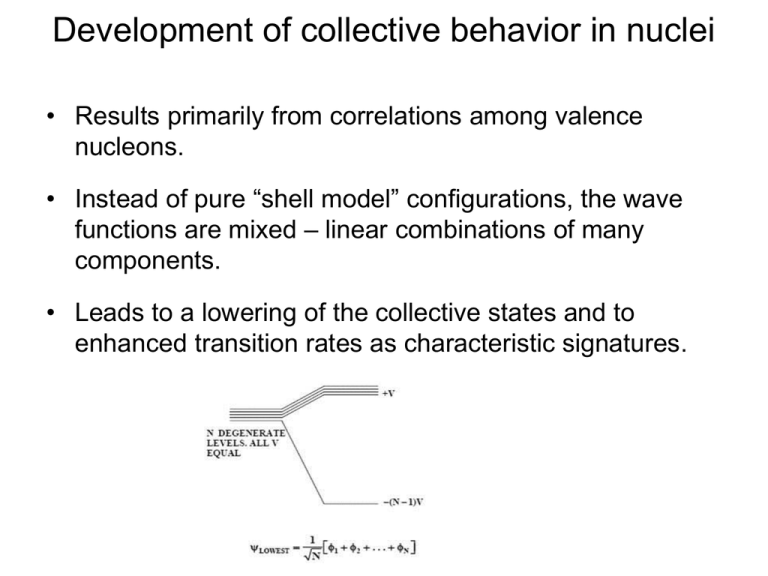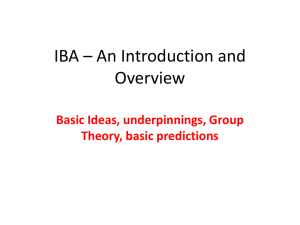Lecture 2
advertisement

Development of collective behavior in nuclei
• Results primarily from correlations among valence
nucleons.
• Instead of pure “shell model” configurations, the wave
functions are mixed – linear combinations of many
components.
• Leads to a lowering of the collective states and to
enhanced transition rates as characteristic signatures.
W
The more
configurations
that mix, the
stronger the
B(E2) value and
the lower the
energy of the
collective state.
Fundamental
property of
collective states.
|2>
V ~ C2b2
Deformed, ellipsoidal, rotational nuclei
Lets look at a typical example and see
the various aspects of structure it
shows
Axially symmetric case
Axial asymmetry
Rotational states built on
(superposed on)
vibrational modes
Vibrational
excitations
Rotational
states
8+
Ground or
equilibrium
state
6+
4+
2++
0
V ~ C2b2
+ C3 b3 cos 3 g
+ C4b4
Axial asymmetry (Triaxiality)
(Specified in terms of the coordinate g (in degrees), either from 0 –> 60 or
from -30 –> +30 degrees – zero degrees is axially symmetric)
g - rigid
V(g)
axially
“symm”
g
g - soft (flat,
unstable)
V(g)
g
g
C3= 0
V ~ C2b2 + C3cos 3 g b3 + C4b4
Note: for axially symm. deformed nuclei, MUST have a large C3 term
Axial Asymmetry in Nuclei – two types
E~ L(L+3)~J(J+6)
6+
5+
4+
3+
Note
staggering
in gamma
band
energies
Gamma Rigid
Davydov, Gamma rigid
Gamma Soft
Wilets-Jean, Gamma unstable
Use staggering in gamma band energies as
signature for the kind of axial asymmetry
Overview of yrast energies
Can express energies as E ~ J ( J + X )
E~ J(J+1)
E~ J(J+6)
)
8
E~ J~J(J+
Now that we know some simple models of
atomic nuclei, how do we know where each of
these structures will appear? How does structure
vary with Z and N? What do we know?
• Near closed shells nuclei are spherical and can be described
in terms of a few shell model configurations.
• As valence nucleons are added, configuration mixing,
collectivity and, eventually, deformation develop. Nuclei
near mid-shell are collective and deformed.
• The driver of this evolution is a competition between the
pairing force and the p-n interaction, both primarily
acting on the valence nucleons.
Estimating the properties of nuclei
We know that
We know that
134Te
(52, 82) is spherical and noncollective.
170Dy
(66, 104) is doubly mid-shell and
very collective.
What about:
156Te
(52, 104)
156Gd
(64, 92)
184Pt
(78, 106) ???
All have 24 valence nucleons. What are their relative
structures ???
Valence Proton-Neutron Interaction
Development of configuration mixing,
collectivity and deformation – competition
with pairing
Changes in single particle energies and
magic numbers
Partial history: Goldhaber and de Shalit (1953); Talmi (1962);
Federman and Pittel ( late 1970’s); Casten et al (1981); Heyde et al
(1980’s); Nazarewicz, Dobacewski et al (1980’s); Otsuka et al( 2000’s);
Cakirli et al (2000’s); and many others.
The idea of “both” types of nucleons – the
p-n interaction
Sn – Magic: no
valence p-n
interactions
Both valence
protons and
neutrons
If p-n interactions drive configuration mixing, collectivity
and deformation, perhaps they can be exploited to
understand the evolution of structure.
Lets assume, just to play with an idea, that all p-n
interactions have the same strength. This is not realistic
since the interaction strength depends on the orbits the
particles occupy, but, maybe, on average, it might be OK.
How many valence p-n interactions are there? Np x Nn
If all are equal then the integrated p-n strength should
scale with Np x Nn
The NpNn Scheme
Valence Proton-Neutron Interactions
Correlations, collectivity, deformation. Sensitive to magic numbers.
NpNn
Scheme
P = NpNn/ (Np+Nn)
p-n interactions per
pairing interaction
Highlight
deviant
nuclei
The NpNn scheme: Interpolation vs.
Extrapolation
Predicting new nuclei with the NpNn Scheme
All the nuclei marked with x’s can be predicted by INTERpolation
Competition between pairing
and the p-n interactions
A simple microscopic guide to the
evolution of structure
(The next slides allow you to estimate the structure of
any nucleus by multiplying and dividing two numbers
each less than 30)
(or, if you prefer, you can get the same result from 10 hours of
supercomputer time)
Valence p-n interaction: Can we measure it?
Vpn (Z,N) =
-¼
[ {B(Z,N)
-
B(Z, N-2)}
p
n
-
{B(Z-2, N)
p
n
Int. of last two n with Z protons,
N-2 neutrons and with each other
p
-
- B(Z-2, N-2)} ]
n
p
n
Int. of last two n with Z-2 protons,
N-2 neutrons and with each other
Empirical average interaction of last two neutrons with last
two protons
Empirical interactions of the last proton with the last neutron
Vpn (Z, N) = -¼{[B(Z, N ) – B(Z, N - 2)]
- [B(Z - 2, N) – B(Z - 2, N -2)]}
p-n / pairing
P=
NpNn
Np + Nn
Pairing int. ~ 1 MeV,
p–n
pairing
p-n interactions per
pairing interaction
p-n ~ 200 keV
Hence takes ~ 5 p-n int. to compete with one pairing int.
P~5
P~5
Comparison with the data
The IBA
The Interacting Boson Approximation Model
A very simple phenomenological model, that can be
extremely parameter-efficient, for collective structure
• Why the IBA
• Basic ideas about the IBA, including a primer on its
Group Theory basis
• The Dynamical Symmetries of the IBA
• Practical calculations with the IBA
IBA – A Review and Practical Tutorial
F. Iachello and A. Arima
Drastic simplification of
shell model
Valence nucleons
Only certain configurations
Simple Hamiltonian – interactions
“Boson” model because it treats nucleons in pairs
2 fermions
boson
Why do we
need to
simplify – why
not just
calculate with
the Shell
Model????
Shell Model Configurations
Fermion
configurations
Roughly, gazillions !!
Need to simplify
The IBA
Boson
configurations
(by considering only
configurations of
pairs of fermions
with J = 0 or 2.)
Assume valence fermions couple in pairs to
bosons of spins 0+ and 2+
IBM
0+
s-boson
2+
d-boson
s boson is like a Cooper pair
d boson is like a generalized pair
• Valence nucleons only
• s, d bosons – creation and destruction operators
H = Hs + Hd + Hinteractions
Number of bosons fixed: N = ns + nd
= ½ # of val. protons + ½ # val. neutrons
Why s, d
bosons?
s
Lowest state of all e-e
nuclei is 0+
- fct gives 0+ ground state
d
First excited state in non-magic
e-e nuclei almost always 2+
- fct gives 2+ next above 0+
Modeling a Nucleus
Why the IBA is the best thing since baseball, a jacket potato,
aceto balsamico, Mt. Blanc, raclette, pfannekuchen, baklava, ….
154Sm
Shell model
Need to truncate
IBA assumptions
1. Only valence nucleons
2. Fermions → bosons
J = 0 (s bosons)
J = 2 (d bosons)
3 x 1014
2+ states
Is it conceivable that
these 26 basis states
are correctly chosen to
account for the
properties of the low
lying collective states?
IBA: 26 2+ states
Why the IBA ?????
• Why a model with such a drastic simplification –
Oversimplification ???
• Answer: Because it works !!!!!
• By far the most successful general nuclear collective
model for nuclei
• Extremely parameter-economic
Note key point:
Bosons in IBA are pairs of fermions in valence shell
Number of bosons for a given nucleus is a fixed number
154
62
S m 92
N = 6
5 = N
NB = 11
Basically the IBA is a Hamiltonian written in terms of s
and d bosons and their interactions. It is written in terms
of boson creation and destruction operators.
Where the IBA fits in the pantheon of nuclear models
D e f.
• Shell Model S p h .
- (Microscopic)
• Geometric – (Macroscopic)
• Third approach — “Algebraic”
Dynamical
Symmetries
Group Theoretical
Phonon-like model with microscopic basis explicit from
the start.
IBA
Shell Mod.
Geom. Mod.
IBA has a deep relation to Group theory
That relation is based on the operators that create, destroy s and d bosons
s†, s,
d †, d
operators
Ang. Mom. 2
d† , d = 2, 1, 0, -1, -2
Hamiltonian is written in terms of s, d operators
Since boson number is conserved for a given nucleus, H can only contain
“bilinear” terms: 36 of them.
s†s, s†d, d†s, d†d
Gr. Theor.
classification
of
Hamiltonian
Group is
called
U(6)
Brief, simple, trip into the Group
Theory of the IBA
DON’T BE SCARED
You do not need to understand all the
details but try to get the idea of the
relation of groups to degeneracies of
levels and quantum numbers
A more intuitive name for this application of Group Theory is
“Spectrum Generating Algebras”
Review of phonon creation and destruction operators
What is a creation operator? Why useful?
A) Bookkeeping – makes calculations very simple.
B) “Ignorance operator”: We don’t know the structure of a phonon but, for many
predictions, we don’t need to know its microscopic basis.
is a b-phonon number operator.
For the IBA a boson is the same as a phonon – think of it as a
collective excitation with ang. mom. 0 (s) or 2 (d).
Concepts of group theory
First, some fancy words with simple meanings: Generators, Casimirs,
Representations, conserved quantum numbers, degeneracy splitting
Generators of a group: Set of operators , Oi that close on commutation.
[ Oi , Oj ] = Oi Oj - Oj Oi = Ok i.e., their commutator gives back 0 or a member of the set
For IBA, the 36 operators
s†s, d†s, s†d, d†d
are generators of the group U(6).
†
†
†
†
Generators
conserve
some
quantum
ex: d † s , s:† define
s n d n and
=
d
ss
s
s
sd
s n d n number.
s
s
N = s†s + d†d = ns + nd
Ex.: 36 Ops of IBA all conserve
= d † sntotal
n dboson
n s - s †number
sd † s n d n s
s
= n s - s †s d †s n d n s
Nthat
, s commutes
= all
s adgroup.
N
e.g: Operator
Casimir:
= nd-s
s nwith
+ 1 N
n the
n s+generators
1, d
n -1 - of
Therefore, its
†
†
†
s
d
s
d
†
s
eigenstates have a specific value of
that group.
energies are defined
= the
N q.#
s of
d
s † dThe
= n d + 1 n s n s - n s - 1 n d + 1, n s -N
1
solely in terms of that q. #. N is Casimir
of U(6).
= Ns †d - Ns †d = 0
†
= n d + 1 n s n d + 1, n s - 1
d s n The
n
Representations of a =group:
set of degenerate states with that value of the q. #.
†
d
s
d † s, s † s = d † s
A Hamiltonian written solely in terms of Casimirs can be solved analytically
or:
Sub-groups:
Subsets of generators that commute among themselves.
e.g: d†d
25 generators—span U(5)
They conserve nd (# d bosons)
Set of states with same nd are the representations of the group [ U(5)]
Summary to here:
Generators: commute, define a q. #, conserve that q. #
Casimir Ops: commute with a set of generators
Conserve that quantum #
A Hamiltonian that can be written in terms of Casimir Operators is then
diagonal for states with that quantum #
Eigenvalues can then be written ANALYTICALLY as a function of that
quantum #
Simple example of dynamical symmetries, group chain,
degeneracies
[H, J 2 ] = [H, J Z ] = 0
J, M constants of motion
Let’s illustrate group chains and degeneracy-breaking.
Consider a Hamiltonian that is a function ONLY of:
That is:
s†s + d†d
H = a(s†s + d†d) = a (ns + nd ) = aN
In H, the energies depend ONLY on the total number of bosons, that is, on the total
number of valence nucleons.
ALL the states with a given N are degenerate. That is, since a given nucleus has a
given number of bosons, if H were the total Hamiltonian, then all the levels of the
nucleus would be degenerate. This is not very realistic (!!!) and suggests that we
should add more terms to the Hamiltonian. I use this example though to illustrate
the idea of successive steps of degeneracy breaking being related to different groups
and the quantum numbers they conserve.
The states with given N are a “representation” of the group U(6) with the quantum
number N. U(6) has OTHER representations, corresponding to OTHER values of N,
but THOSE states are in DIFFERENT NUCLEI (numbers of valence nucleons).
H’ = H + b d†d = aN + b nd
Now, add a term to this Hamiltonian:
Now the energies depend not only on N but also on
nd
States of a given nd are now degenerate. They are
“representations” of the group U(5). States with
different nd are not degenerate
2a N + 2
a
H’ = aN + b d†d = a N + b nd
N+1
b
2
1
0
0
2b
N
0
nd
E
U(6)
H’ = aN
U(5)
+
b d† d
OK, here’s the key point :
Concept of a Dynamical Symmetry
N
Next time
Deformed
Sph.
Classifying Structure -- The Symmetry Triangle










